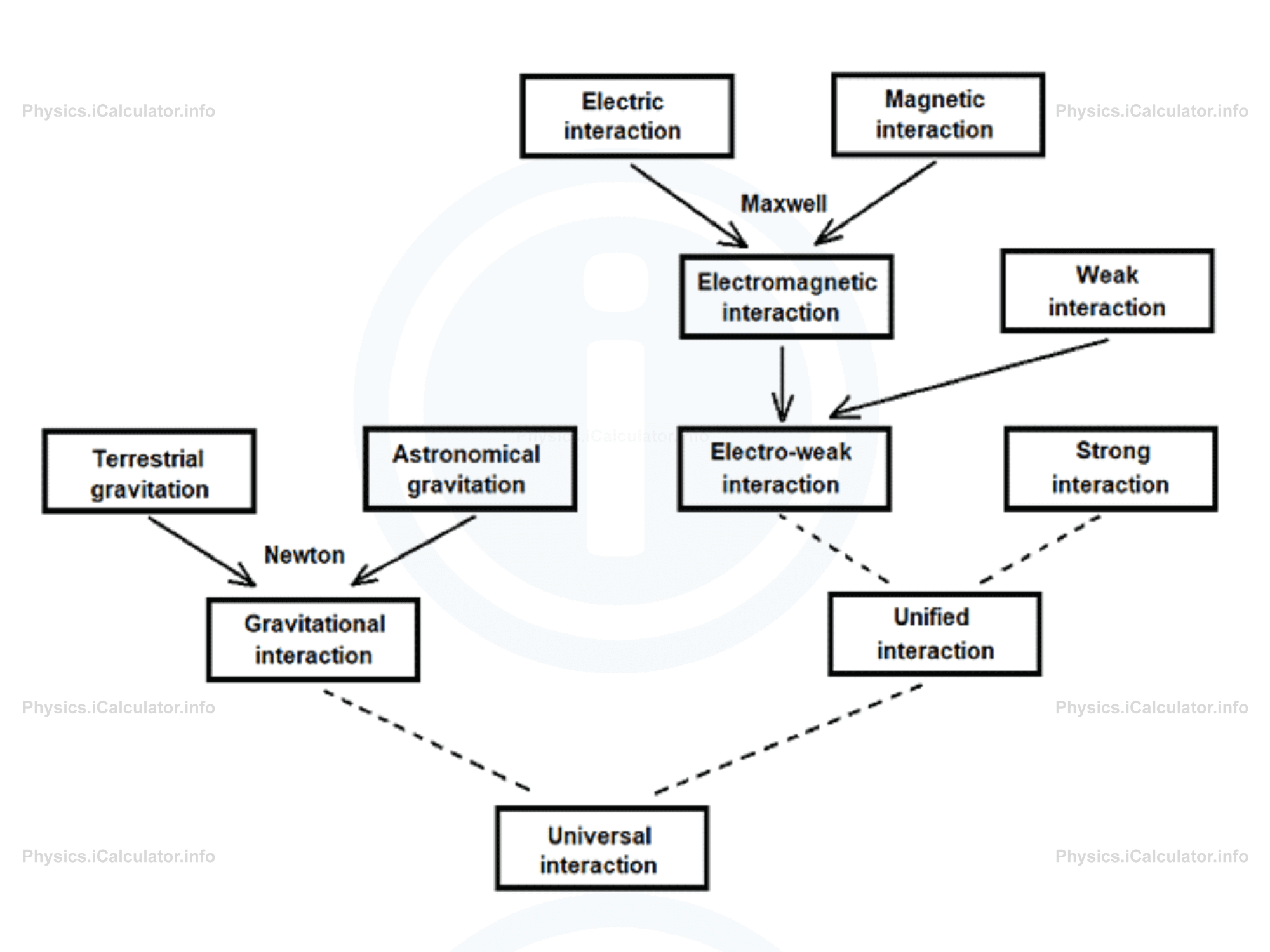Menu
Physics Lesson 21.3.6 - Unification of Interactions
Please provide a rating, it takes seconds and helps us to keep this resource free for all to use
Welcome to our Physics lesson on Unification of Interactions, this is the sixth lesson of our suite of physics lessons covering the topic of Classification of Elementary Particles. Quarks and Charm, you can find links to the other lessons within this tutorial and access additional physics learning resources below this lesson.
Unification of Interactions
The list of fundamental interaction has experienced many changes during various stages of science development. Prior to Newton's work, people didn't have the minimum idea about the weak and strong interactions existence. He was the first who realized that in essence, terrestrial and celestial gravitation are the same thing. Likewise, Maxwell unified the electric and magnetic interaction between charged particle by introducing the idea of electromagnetic interaction.
Scientists have always sought to merge all types of interactions in a single theory known as the theory of universal interaction. The first concrete steps in this regard are made by Einstein, who spent much of his time trying to unify the fields theory, in which gravitational and electromagnetic fields would be included. He was partially successful in his attempts.
Later on (in 1967) a group of scientists proposed the idea of unification of weak and electromagnetic interaction. According to this idea, Z0 particles and W- and W+ bosons (including their corresponding masses as well) are considered as mediators of such interaction. More specifically, this theory supports the idea that the difference in mass between photons (that have zero mass) and weak bosons makes the weak and electromagnetic interaction unaffected by low energy states but very sensible by high energy ones (1 TeV). This theory was confirmed experimentally in 1983.
Likewise, many attempts are made in trying to unify the electro-weak interactions with the strong ones. If confirmed experimentally this unification would be the last stage of the general theory of unification, which will be one of the most important discoveries in science. The scheme below shows the path towards the general theory of unification where the already linked interactions are connected through bold arrows while those still to be confirmed are connected through dashed lines.

You have reached the end of Physics lesson 21.3.6 Unification of Interactions. There are 6 lessons in this physics tutorial covering Classification of Elementary Particles. Quarks and Charm, you can access all the lessons from this tutorial below.
More Classification of Elementary Particles. Quarks and Charm Lessons and Learning Resources
Whats next?
Enjoy the "Unification of Interactions" physics lesson? People who liked the "Classification of Elementary Particles. Quarks and Charm lesson found the following resources useful:
- Unification Feedback. Helps other - Leave a rating for this unification (see below)
- Elementary Particles Physics tutorial: Classification of Elementary Particles. Quarks and Charm. Read the Classification of Elementary Particles. Quarks and Charm physics tutorial and build your physics knowledge of Elementary Particles
- Elementary Particles Revision Notes: Classification of Elementary Particles. Quarks and Charm. Print the notes so you can revise the key points covered in the physics tutorial for Classification of Elementary Particles. Quarks and Charm
- Elementary Particles Practice Questions: Classification of Elementary Particles. Quarks and Charm. Test and improve your knowledge of Classification of Elementary Particles. Quarks and Charm with example questins and answers
- Check your calculations for Elementary Particles questions with our excellent Elementary Particles calculators which contain full equations and calculations clearly displayed line by line. See the Elementary Particles Calculators by iCalculator™ below.
- Continuing learning elementary particles - read our next physics tutorial: Elementary Particles
Help others Learning Physics just like you
Please provide a rating, it takes seconds and helps us to keep this resource free for all to use
We hope you found this Physics lesson "Classification of Elementary Particles. Quarks and Charm" useful. If you did it would be great if you could spare the time to rate this physics lesson (simply click on the number of stars that match your assessment of this physics learning aide) and/or share on social media, this helps us identify popular tutorials and calculators and expand our free learning resources to support our users around the world have free access to expand their knowledge of physics and other disciplines.